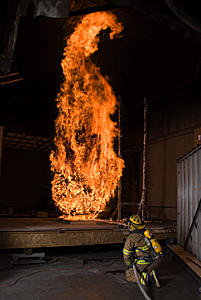
Controlled experiment at NIST's National Fire Research Laboratory yields data that inform approaches to preventing and fighting fires at the wildland-urban interface.
The United States already has one of the highest direct fire loss rates among developed nations, and progress in reducing this tremendous burden is slowing.
Fires claim more than 3,000 lives a year, injure more than 90,000 firefighters and civilians, and impose costs and losses totaling more than $300 billion—equivalent to about 2 percent of the nation's gross domestic product.
Fire researchers at the National Institute of Standards and Technology (NIST) believe that the devastating annual toll can be significantly reduced over the next two decades. Even better, they have a plan that prioritizes and details the research and other work needed to enable that goal.
Crafted with input from fire service organizations, standards and building-code developers, equipment manufacturers, insurers and others, NIST's newly issued "strategic roadmap"* lays out a clear technological course for reducing the risk of fire in buildings and communities. It calls for tackling the nation's fire problem on three fronts:
- Reducing fire hazards in buildings,
- Advancing firefighter technologies, and
- Reducing the risk of fire in communities bordering forests and "wildlands."
The new roadmap is NIST's most comprehensive effort to establish fire-risk reduction goals for its programs since the influential America Burning report was published in the mid-1970s.
In response to that report, Congress established a center for fire research at NIST. The report's recommendations served as goals for attacking the nation's fire problem. Over the last several decades, research-enabled advances have paid off with improvements in fire safety and related benefits.
For example, results of fire research have led to standards for children's sleepwear, automatic sprinklers, reduced-ignition-propensity cigarettes, modernized building codes, and computer models that can predict the behavior of fire, smoke and toxic products.
Since the early 1980s, the number of fires has been cut by more than half and the fire-caused civilian deaths and injuries have been reduced by nearly half.
"The nation has made major progress in improving fire safety over the last few decades due to the combined and concerted efforts of many organizations," says Shyam Sunder, director of NIST's Engineering Laboratory. "But fire losses are still too high, and there are new and potentially costly threats to fire safety that are emerging in communities across the country. At the same time, advances in materials, computing and other technologies present opportunities to launch a new wave of improvements in fire protection and safety."
Reflecting NIST's unique technical support role, the new roadmap sets targets for new measurement capabilities that underpin innovation in fire-risk-reducing technologies and best practices. These advanced capabilities are required to overcome technical hurdles that stand in the way of nascent or current technologies with the potential to deliver a wide range of fire safety benefits. These range from earlier fire detection and fire-safety improvements in the design and construction of buildings and communities, to better firefighting equipment and tactics, to more effective approaches to preventing and responding to "wildland-urban interface" fires, a rapidly growing national fire problem.
The new NIST roadmap sets short, medium and long-term goals—from fewer than three years to more than eight—for eliminating these gaps and accomplishing the overall objective of reducing the nation's fire burden by a third. The publication is available at www.nist.gov/manuscript-publication-search.cfm?pub_id=909653.
*Fire Research Division, Engineering Laboratory, Reducing the Risk of Fire in Buildings and Communities: A Strategic Roadmap to Guide and Prioritize Research, NIST Special Publication 1130, April 2012.

